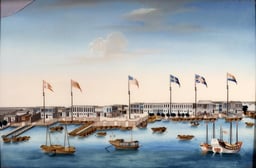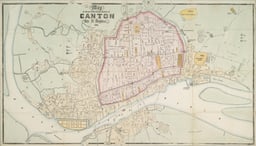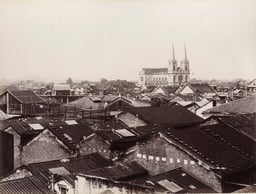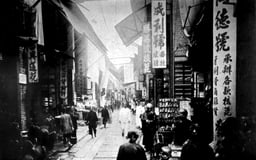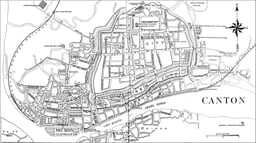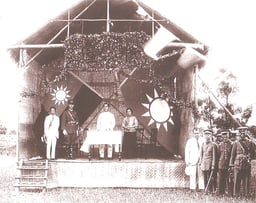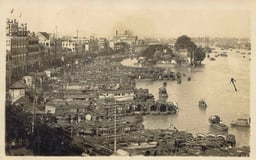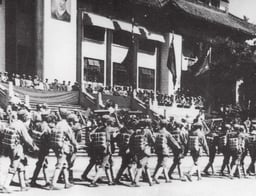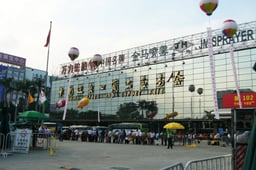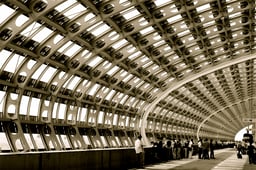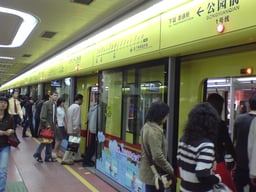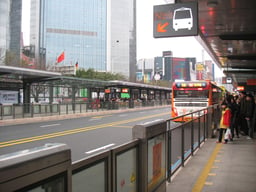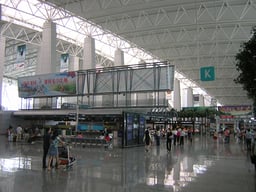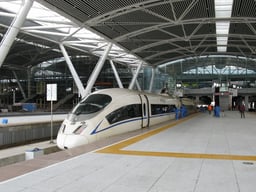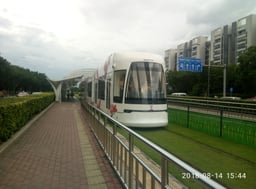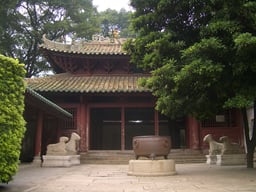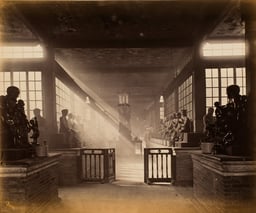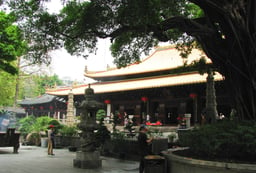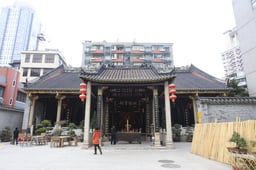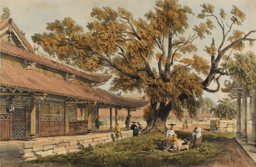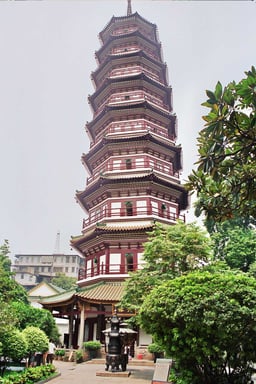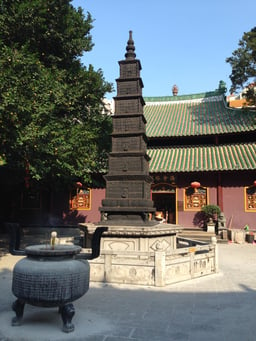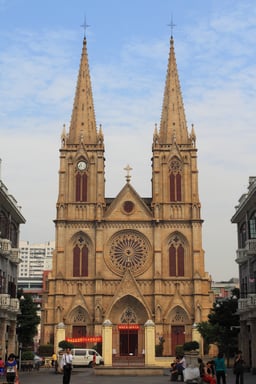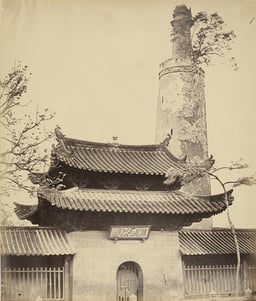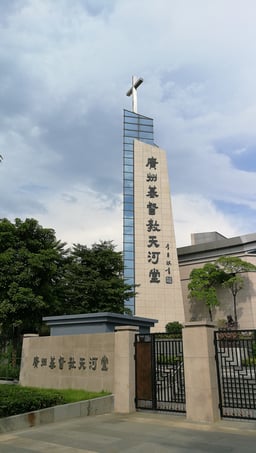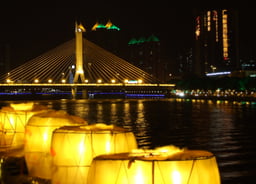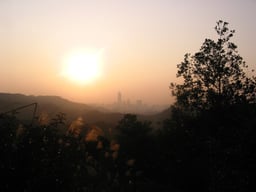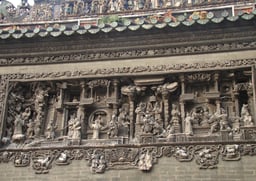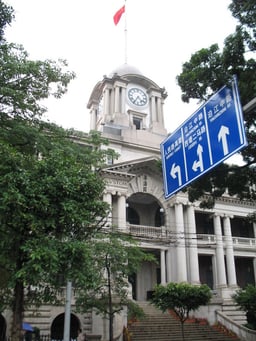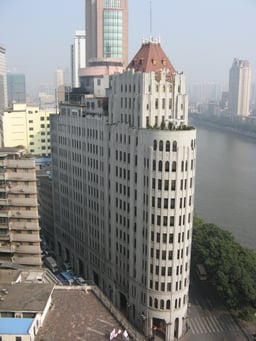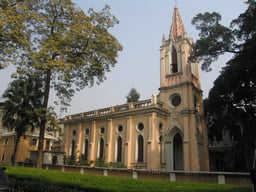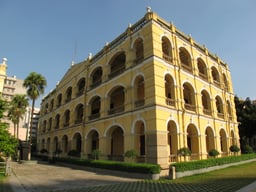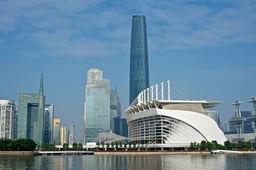Guangzhou
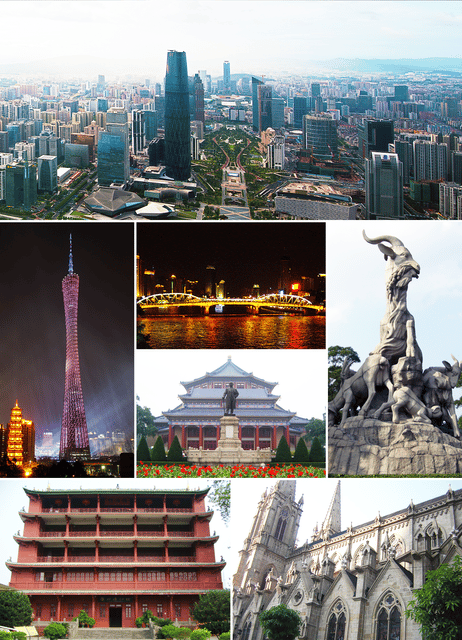
Guangzhou

Guangzhou 广州市 Canton; Kwangchow | |||||||||||||||||||||||||||||||||||||
|---|---|---|---|---|---|---|---|---|---|---|---|---|---|---|---|---|---|---|---|---|---|---|---|---|---|---|---|---|---|---|---|---|---|---|---|---|---|
Prefecture-level and Sub-provincial city | |||||||||||||||||||||||||||||||||||||
| Nicknames: City of Rams, City of Flowers, Suicheng, others | |||||||||||||||||||||||||||||||||||||
 | |||||||||||||||||||||||||||||||||||||
 Location of Guangzhou City jurisdiction in Guangdong | |||||||||||||||||||||||||||||||||||||
| Coordinates (Guangdong People's Government):23°07′55″N 113°15′58″E [209] | |||||||||||||||||||||||||||||||||||||
| Country | People's Republic of China | ||||||||||||||||||||||||||||||||||||
| Province | Guangdong | ||||||||||||||||||||||||||||||||||||
| Government | |||||||||||||||||||||||||||||||||||||
| • Type | Sub-provincial city | ||||||||||||||||||||||||||||||||||||
| • CPC Ctte Secretary | Zhang Shuofu | ||||||||||||||||||||||||||||||||||||
| • Mayor | Wen Guohui | ||||||||||||||||||||||||||||||||||||
| Area | |||||||||||||||||||||||||||||||||||||
| • Prefecture-level and Sub-provincial city | 7,434.4 km2(2,870 sq mi) | ||||||||||||||||||||||||||||||||||||
| • Urban | 3,843.43 km2(1,483.95 sq mi) | ||||||||||||||||||||||||||||||||||||
| Elevation | 21 m (68 ft) | ||||||||||||||||||||||||||||||||||||
| Population (2018 end)[11] | |||||||||||||||||||||||||||||||||||||
| • Prefecture-level and Sub-provincial city | 14,904,400 | ||||||||||||||||||||||||||||||||||||
| • Density | 2,000/km2(5,200/sq mi) | ||||||||||||||||||||||||||||||||||||
| • Urban | 11,547,491 | ||||||||||||||||||||||||||||||||||||
| • Metro (2010)[13] | 25 million | ||||||||||||||||||||||||||||||||||||
| Demonym(s) | Cantonese | ||||||||||||||||||||||||||||||||||||
| Time zone | UTC+8 (China standard time) | ||||||||||||||||||||||||||||||||||||
| Postal code | 510000 | ||||||||||||||||||||||||||||||||||||
| Area code(s) | (0)20 | ||||||||||||||||||||||||||||||||||||
| ISO 3166 code | CN-GD-01 | ||||||||||||||||||||||||||||||||||||
| GDP (nominal)[14] | 2018 | ||||||||||||||||||||||||||||||||||||
| - Total | ¥2.3 trillion $347 billion ($0.66 trillion, PPP) | ||||||||||||||||||||||||||||||||||||
| - Per capita | ¥158,638 $23,963 ($46,778, PPP) | ||||||||||||||||||||||||||||||||||||
| - Growth | |||||||||||||||||||||||||||||||||||||
| Licence plate prefixes | 粤A | ||||||||||||||||||||||||||||||||||||
| City Flower | Bombax ceiba | ||||||||||||||||||||||||||||||||||||
| City Bird | Chinese hwamei | ||||||||||||||||||||||||||||||||||||
| Languages | Cantonese, Mandarin | ||||||||||||||||||||||||||||||||||||
| Website | english.gz.gov.cn [210] | ||||||||||||||||||||||||||||||||||||
| Guangzhou | |||||||||||||||||||||||||||||||||||||
 "Guangzhou" in Traditional (top) and Simplified (bottom) Chinese characters | |||||||||||||||||||||||||||||||||||||
| Simplified Chinese | 广州 | ||||||||||||||||||||||||||||||||||||
| Traditional Chinese | 廣州 | ||||||||||||||||||||||||||||||||||||
| Postal | Canton Kwangchow | ||||||||||||||||||||||||||||||||||||
| Literal meaning | Broad Prefecture | ||||||||||||||||||||||||||||||||||||
| |||||||||||||||||||||||||||||||||||||
| abbreviation | |||||||||||||||||||||||||||||||||||||
| Chinese | 穗 | ||||||||||||||||||||||||||||||||||||
| |||||||||||||||||||||||||||||||||||||
| Former names | |||||||||||||||||||||||||||||||||||||
| Nanwucheng | |||||||||||||||||||||||||||||||||||||
| Chinese | 南武城 | ||||||||||||||||||||||||||||||||||||
| Literal meaning | Southern Wucheng | ||||||||||||||||||||||||||||||||||||
| |||||||||||||||||||||||||||||||||||||
| Panyu | |||||||||||||||||||||||||||||||||||||
| Chinese | 番禺 | ||||||||||||||||||||||||||||||||||||
| |||||||||||||||||||||||||||||||||||||
| Guangfu Provincial Capital | |||||||||||||||||||||||||||||||||||||
| Traditional Chinese | 廣府 省城 | ||||||||||||||||||||||||||||||||||||
| Simplified Chinese | 广府 省城 | ||||||||||||||||||||||||||||||||||||
| Literal meaning | Broad Prefecture Provincial City | ||||||||||||||||||||||||||||||||||||
| |||||||||||||||||||||||||||||||||||||
| Xingwang | |||||||||||||||||||||||||||||||||||||
| Traditional Chinese | 興王 | ||||||||||||||||||||||||||||||||||||
| Simplified Chinese | 兴王 | ||||||||||||||||||||||||||||||||||||
| Literal meaning | Happy King | ||||||||||||||||||||||||||||||||||||
| |||||||||||||||||||||||||||||||||||||
| Informal names | |||||||||||||||||||||||||||||||||||||
| City of Rams City of the Five Rams | |||||||||||||||||||||||||||||||||||||
| Chinese | 羊城 五羊城 | ||||||||||||||||||||||||||||||||||||
| Literal meaning | Goat/Sheep City Five Goat/Sheep City | ||||||||||||||||||||||||||||||||||||
| |||||||||||||||||||||||||||||||||||||
| City of the Immortals | |||||||||||||||||||||||||||||||||||||
| Chinese | 仙城 | ||||||||||||||||||||||||||||||||||||
| |||||||||||||||||||||||||||||||||||||
| City of Flowers | |||||||||||||||||||||||||||||||||||||
| Chinese | 花城 | ||||||||||||||||||||||||||||||||||||
| |||||||||||||||||||||||||||||||||||||
| Rice City | |||||||||||||||||||||||||||||||||||||
| Chinese | 穗城 | ||||||||||||||||||||||||||||||||||||
| Literal meaning | Rice-ear City | ||||||||||||||||||||||||||||||||||||
| |||||||||||||||||||||||||||||||||||||
Guangzhou (Chinese: 广州; Cantonese pronunciation: [kʷɔ̌ːŋ.tsɐ̂u] or [kʷɔ̌ːŋ.tsɐ́u] (listen); Mandarin pronunciation: [kwàŋ.ʈʂóu] (listen)), also known as Canton and formerly romanized as Kwangchow or Kwong Chow,[15] is the capital and most populous city of the province of Guangdong in southern China.[16] On the Pearl River about 120 km (75 mi) north-northwest of Hong Kong and 145 km (90 mi) north of Macau, Guangzhou has a history of over 2,200 years and was a major terminus of the maritime Silk Road,[17] and continues to serve as a major port and transportation hub, as well as one of China's three largest cities.[18]
Guangzhou is at the heart of the most-populous built-up metropolitan area in mainland China that extends into the neighboring cities of Foshan, Dongguan, Zhongshan and Shenzhen, forming one of the largest urban agglomerations on the planet. Administratively, the city holds sub-provincial status[19] and is one of China's nine National Central Cities.[20] At the end of 2018, the population of the city's expansive administrative area is estimated at 14,904,400 by city authorities, up 3.8% year from the previous year.[21] Guangzhou is ranked as an Alpha global city.[22] There is a rapidly increasing number of foreign temporary residents and immigrants from Southeast Asia, the Middle East, Eastern Europe and Africa.[23][24] This has led to it being dubbed the "Capital of the Third World".[25]
The domestic migrant population from other provinces of China in Guangzhou was 40% of the city's total population in 2008. Together with Shanghai, Beijing and Shenzhen, Guangzhou has one of the most expensive real estate markets in China.[26] In the late 1990s and early 2000s, nationals of sub-Saharan Africa who had initially settled in the Middle East and other parts of Southeast Asia moved in unprecedented numbers to Guangzhou in response to the 1997/98 Asian financial crisis.[27]
Long the only Chinese port accessible to most foreign traders, Guangzhou fell to the British during the First Opium War. No longer enjoying a monopoly after the war, it lost trade to other ports such as Hong Kong and Shanghai, but continued to serve as a major entrepôt. In modern commerce, Guangzhou is best known for its annual Canton Fair, the oldest and largest trade fair in China. For three consecutive years (2013–2015), Forbes ranked Guangzhou as the best commercial city in mainland China.[28]
Guangzhou 广州市 Canton; Kwangchow | |||||||||||||||||||||||||||||||||||||
|---|---|---|---|---|---|---|---|---|---|---|---|---|---|---|---|---|---|---|---|---|---|---|---|---|---|---|---|---|---|---|---|---|---|---|---|---|---|
Prefecture-level and Sub-provincial city | |||||||||||||||||||||||||||||||||||||
| Nicknames: City of Rams, City of Flowers, Suicheng, others | |||||||||||||||||||||||||||||||||||||
 | |||||||||||||||||||||||||||||||||||||
 Location of Guangzhou City jurisdiction in Guangdong | |||||||||||||||||||||||||||||||||||||
| Coordinates (Guangdong People's Government):23°07′55″N 113°15′58″E [209] | |||||||||||||||||||||||||||||||||||||
| Country | People's Republic of China | ||||||||||||||||||||||||||||||||||||
| Province | Guangdong | ||||||||||||||||||||||||||||||||||||
| Government | |||||||||||||||||||||||||||||||||||||
| • Type | Sub-provincial city | ||||||||||||||||||||||||||||||||||||
| • CPC Ctte Secretary | Zhang Shuofu | ||||||||||||||||||||||||||||||||||||
| • Mayor | Wen Guohui | ||||||||||||||||||||||||||||||||||||
| Area | |||||||||||||||||||||||||||||||||||||
| • Prefecture-level and Sub-provincial city | 7,434.4 km2(2,870 sq mi) | ||||||||||||||||||||||||||||||||||||
| • Urban | 3,843.43 km2(1,483.95 sq mi) | ||||||||||||||||||||||||||||||||||||
| Elevation | 21 m (68 ft) | ||||||||||||||||||||||||||||||||||||
| Population (2018 end)[11] | |||||||||||||||||||||||||||||||||||||
| • Prefecture-level and Sub-provincial city | 14,904,400 | ||||||||||||||||||||||||||||||||||||
| • Density | 2,000/km2(5,200/sq mi) | ||||||||||||||||||||||||||||||||||||
| • Urban | 11,547,491 | ||||||||||||||||||||||||||||||||||||
| • Metro (2010)[13] | 25 million | ||||||||||||||||||||||||||||||||||||
| Demonym(s) | Cantonese | ||||||||||||||||||||||||||||||||||||
| Time zone | UTC+8 (China standard time) | ||||||||||||||||||||||||||||||||||||
| Postal code | 510000 | ||||||||||||||||||||||||||||||||||||
| Area code(s) | (0)20 | ||||||||||||||||||||||||||||||||||||
| ISO 3166 code | CN-GD-01 | ||||||||||||||||||||||||||||||||||||
| GDP (nominal)[14] | 2018 | ||||||||||||||||||||||||||||||||||||
| - Total | ¥2.3 trillion $347 billion ($0.66 trillion, PPP) | ||||||||||||||||||||||||||||||||||||
| - Per capita | ¥158,638 $23,963 ($46,778, PPP) | ||||||||||||||||||||||||||||||||||||
| - Growth | |||||||||||||||||||||||||||||||||||||
| Licence plate prefixes | 粤A | ||||||||||||||||||||||||||||||||||||
| City Flower | Bombax ceiba | ||||||||||||||||||||||||||||||||||||
| City Bird | Chinese hwamei | ||||||||||||||||||||||||||||||||||||
| Languages | Cantonese, Mandarin | ||||||||||||||||||||||||||||||||||||
| Website | english.gz.gov.cn [210] | ||||||||||||||||||||||||||||||||||||
| Guangzhou | |||||||||||||||||||||||||||||||||||||
 "Guangzhou" in Traditional (top) and Simplified (bottom) Chinese characters | |||||||||||||||||||||||||||||||||||||
| Simplified Chinese | 广州 | ||||||||||||||||||||||||||||||||||||
| Traditional Chinese | 廣州 | ||||||||||||||||||||||||||||||||||||
| Postal | Canton Kwangchow | ||||||||||||||||||||||||||||||||||||
| Literal meaning | Broad Prefecture | ||||||||||||||||||||||||||||||||||||
| |||||||||||||||||||||||||||||||||||||
| abbreviation | |||||||||||||||||||||||||||||||||||||
| Chinese | 穗 | ||||||||||||||||||||||||||||||||||||
| |||||||||||||||||||||||||||||||||||||
| Former names | |||||||||||||||||||||||||||||||||||||
| Nanwucheng | |||||||||||||||||||||||||||||||||||||
| Chinese | 南武城 | ||||||||||||||||||||||||||||||||||||
| Literal meaning | Southern Wucheng | ||||||||||||||||||||||||||||||||||||
| |||||||||||||||||||||||||||||||||||||
| Panyu | |||||||||||||||||||||||||||||||||||||
| Chinese | 番禺 | ||||||||||||||||||||||||||||||||||||
| |||||||||||||||||||||||||||||||||||||
| Guangfu Provincial Capital | |||||||||||||||||||||||||||||||||||||
| Traditional Chinese | 廣府 省城 | ||||||||||||||||||||||||||||||||||||
| Simplified Chinese | 广府 省城 | ||||||||||||||||||||||||||||||||||||
| Literal meaning | Broad Prefecture Provincial City | ||||||||||||||||||||||||||||||||||||
| |||||||||||||||||||||||||||||||||||||
| Xingwang | |||||||||||||||||||||||||||||||||||||
| Traditional Chinese | 興王 | ||||||||||||||||||||||||||||||||||||
| Simplified Chinese | 兴王 | ||||||||||||||||||||||||||||||||||||
| Literal meaning | Happy King | ||||||||||||||||||||||||||||||||||||
| |||||||||||||||||||||||||||||||||||||
| Informal names | |||||||||||||||||||||||||||||||||||||
| City of Rams City of the Five Rams | |||||||||||||||||||||||||||||||||||||
| Chinese | 羊城 五羊城 | ||||||||||||||||||||||||||||||||||||
| Literal meaning | Goat/Sheep City Five Goat/Sheep City | ||||||||||||||||||||||||||||||||||||
| |||||||||||||||||||||||||||||||||||||
| City of the Immortals | |||||||||||||||||||||||||||||||||||||
| Chinese | 仙城 | ||||||||||||||||||||||||||||||||||||
| |||||||||||||||||||||||||||||||||||||
| City of Flowers | |||||||||||||||||||||||||||||||||||||
| Chinese | 花城 | ||||||||||||||||||||||||||||||||||||
| |||||||||||||||||||||||||||||||||||||
| Rice City | |||||||||||||||||||||||||||||||||||||
| Chinese | 穗城 | ||||||||||||||||||||||||||||||||||||
| Literal meaning | Rice-ear City | ||||||||||||||||||||||||||||||||||||
| |||||||||||||||||||||||||||||||||||||
History
Etymology

A Qing-era portrait of the Grotto of the Five Immortals, the Taoist temple around the five stones which gave Guangzhou its nickname "The City of Rams".
Guǎngzhōu is the pinyin romanisation of the Chinese name 廣州, which was simplified in mainland China to 广州 in the 1950s. The name of the city is taken from the ancient Guang Province (Guang Zhou), after it had become the prefecture's seat of government, which is how some other Chinese cities, including Hangzhou, Suzhou, and Fuzhou got their names. The character 廣 or 广—which also appears in the names of the provinces Guangdong and Guangxi, together called the Liangguang—means "broad" or "expansive" and refers to the intention to dispense imperial grace broadly in the region with the founding of county of Guangxin in Han Dynasty.
Before acquiring its current name, the town was known as Panyu, a name still borne by one of Guangzhou's districts not far from the main city. The origin of the name is still uncertain, with 11 various explanations being offered,[29] including that it may have referred to two local mountains.[30][31] The city has also sometimes been known as Guangzhou Fu or Guangfu after its status as the capital of a prefecture. From this latter name, Guangzhou was known to medieval Persians such as Al-Masudi and Ibn Khordadbeh[32] as Khanfu (خانفو).[33] Under the Southern Han, the city was renamed Xingwang.[34][35]
The Chinese abbreviation for Guangzhou is "穗" (although the abbreviation on car license plates, as with the rest of the province, is 粤), after its nickname "Rice City". The city has long borne the nickname City of Rams or City of the Five Rams from the five stones at the old Temple of the Five Immortals said to have been the sheep or goats ridden by the Taoist culture heroes credited with introducing rice cultivation to the area around the time of the city's foundation.[36] The former name "City of the Immortals" came from the same story. The more recent City of Flowers is usually taken as a simple reference to the area's fine greenery.
The English name "Canton" derived from Portuguese Cantão[37] or Cidade de Cantão,[38] a muddling of dialectical pronunciations of "Guangdong"[39][40] (e.g., Hakka Kóng-tûng). Although it originally and chiefly applied to the walled city, it was occasionally conflated with Guangdong by some authors.[41][43] It was adopted as the Postal Map Romanization of Guangzhou and remained in common use until the gradual adoption of pinyin. As an adjective, it is still used in describing the people, language, cuisine and culture of Guangzhou and the surrounding Liangguang region. The 19th-century name "Kwang-chow foo"[44] derived from Nanjing dialect of Mandarin and the town's status as a prefectural capital.
Prehistory
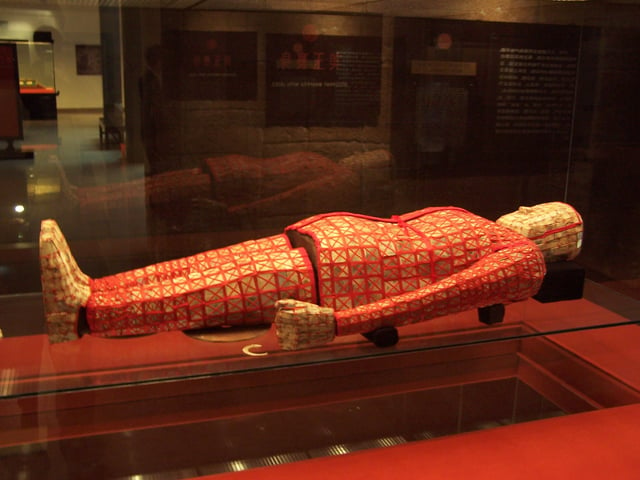
The jade burial suit of Zhao Mo in Guangzhou's Nanyue King Museum
Nanyue
Panyu was established on the east bank of the Pearl River[44] in 214 BC to serve as a base for the Qin Empire's first failed invasion of the Baiyue lands in southern China. Legendary accounts claimed the soldiers at Panyu were so vigilant that they did not remove their armor for three years.[49] Upon the fall of the Qin, General Zhao Tuo established his own kingdom of Nanyue and made Panyu its capital in 204 BC. It remained independent through the Chu-Han Contention, although Zhao negotiated recognition of his independence in exchange for his nominal submission to the Han in 196 BC.[50] Archaeological evidence shows that Panyu was an expansive commercial centre: in addition to items from central China, archaeologists have found remains originating from Southeast Asia, India, and even Africa.[51] Zhao Tuo was succeeded by Zhao Mo and then Zhao Yingqi. Upon Zhao Yingqi's death in 115 BC, his younger son Zhao Xing was named as his successor in violation of Chinese primogeniture. By 113 BC, his Chinese mother, the Empress Dowager Jiu (樛) had prevailed upon him to submit Nanyue as a formal part of the Han Empire. The native prime minister Lü Jia (呂嘉) launched a coup, killing Han ambassadors along with the king, his mother, and their supporters.[52] A successful ambush then annihilated a Han force which had been sent to arrest him. The enraged Emperor Wu launched a massive river- and sea-borne invasion: six armies under Lu Bode and Yang Pu[53] took Panyu and annexed Nanyue by the end of 111 BC.[52]
Imperial China

Guangzhou (as 廣) on the 1136 Map of the Tracks of Yu

Lai Afong's photograph of a commercial street in Guangzhou c. 1880

Guangzhou ("Canton") and the surrounding islands of Henan ("Hanan"), Pazhou ("Whampoa"), Changzhou ("Dane's Island"), and Xiaoguwei ("French Island") during the First Opium War's Second Battle of Canton. The large East Indiamen of the Canton trade used the anchorage sheltered by these four islands, but the village and island of Huangpu for which it was named make up no part of present-day Guangzhou's Huangpu District.
Incorporated into the Han Dynasty, Panyu became a provincial capital. In AD 226, it became the seat of Guang Prefecture, which gave it its modern name. The Old Book of Tang described Guangzhou as an important port in southern China.[54] Direct routes connected the Middle East and China, as shown in records of a Chinese prisoner returning home from Iraq twelve years after his capture at Talas.[55] Relations were not always peaceful: Muslims sacked the city on 30 October 758[1][56][57][58][59] and were massacred by the Chinese rebel Huang Chao in 878, along with the city's Jews, Christians,[60][61][62] and Parsis.[63][64]
Amid the Five Dynasties and Ten Kingdoms that followed the collapse of the Tang dynasty, the Later Liang governor Liu Yan used his base at Panyu to establish a "Great Yue" or "Southern Han" empire, which lasted from 917 to 971. The region enjoyed considerable cultural and economic success in this period. From the 10th to 12th century, there are records that the large foreign communities were not exclusively male, but included "Persian women".[65][66][2] Guangzhou was visited by the Moroccan traveler Ibn Battuta during his 14th-century journey around the world;[68] he detailed the process by which the Chinese constructed their large ships in the port's shipyards.[69]
Shortly after the Hongwu Emperor's declaration of the Ming dynasty, he reversed his earlier support of foreign trade and imposed the first of a series of sea bans (haijin).[70] These banned private foreign trade upon penalty of death for the merchant and exile for his family and neighbors.[71] The Yuan-era maritime intendancies of Guangzhou, Quanzhou, and Ningbo were closed in 1384[72] and legal trade became limited to the tribute delegations sent to or by official representatives of foreign governments.[73]
Following the Portuguese conquest of Malacca, Rafael Perestrello travelled to Guangzhou as a passenger on a native junk in 1516.[74] His report induced Fernão Pires de Andrade to sail to the city with eight ships the next year,[74] but De Andrade's exploration[75] was understood as spying[76] and his brother Simão and others began attempting to monopolize trade,[77] enslaving Chinese women[78] and children,[3] engaging in piracy,[80] and fortifying the island of Tamão.[81][82] Rumors even circulated that Portuguese were eating the children.[83][79][4] The Guangzhou administration was charged with driving them off:[80] they bested the Portuguese at the Battle of Tunmen[85] and in Xicao Bay; held a diplomatic mission hostage in a failed attempt to pressure the restoration of the sultan of Malacca,[86] who had been accounted a Ming vassal;[87] and, after placing them in cangues and keeping them for most of a year, ultimately executed 23 by lingchi.[88][5] With the help of local pirates,[83] the "Folangji" then carried out smuggling at Macao, Lampacau, and St John's Island (now Shangchuan),[78] until Leonel de Sousa legalized their trade with bribes to Admiral Wang Bo (汪柏) and the 1554 Luso-Chinese Accord. The Portuguese undertook not to raise fortifications and to pay customs dues;[91] three years later, after providing the Chinese with assistance suppressing their former pirate allies,[92] the Portuguese were permitted to warehouse their goods at Macau instead of Guangzhou itself.[93]
After the fall of Fuzhou in October 1646, the Longwu Emperor's brother Zhu Yuyue fled by sea to Guangzhou. On 11 December, he declared himself the Shaowu Emperor, borrowing his imperial regalia from local theatre troupes.[94] He led a successful offense against his cousin Zhu Youlang but was deposed and executed on 20 January 1647 when the Ming turncoat Li Chengdong (李成東) sacked the city on behalf of the Qing.[95][6]
The Qing became somewhat more open to foreign trade after gaining control of Taiwan in 1683.[96] The Portuguese from Macau and Spaniards from Manila returned, as did private Muslim, Armenian, and English traders.[97] From 1699 to 1714, the French and British East India Companies sent a ship or two each year;[97] the Austrian Ostend General India Co. arrived in 1717,[98] the Dutch East India Co. in 1729,[99] the Danish Asiatic Co. in 1731,[7] and the Swedish East India Co. the next year.[97] These were joined by the occasional Prussian or Trieste Company vessel. The first independent American ship arrived in 1784 and the first colonial Australian one in 1788. By that time, Guangzhou was one of the world's great ports, organised under the Canton System.[101] The main exports were tea and porcelain.[97] As a meeting place of merchants from all over the world, Guangzhou became a major contributor to the rise of the modern global economy.[102]
In the 19th century, most of the city's buildings were still only one or two storeys. The major structures were the Plain Minaret of the Huaisheng Mosque, the Flower Pagoda of the Temple of the Six Banyan Trees, and the guard tower known as the 5-Storey Pagoda. The northern hills, since urbanized, were bare and covered with traditional graves. The brick city walls were about 6 miles (10 km) in circumference, 25 feet (8 m) high, and 20 feet (6 m) wide. Its eight main gates and two water gates all held guards during the day and were closed at night. The wall rose to incorporate a hill on its northern side and was surrounded on the other three by a moat which, along with the canals, functioned as the city's sewer, emptied daily by the river's tides. A partition wall with four gates divided the northern "old town" from the southern "new town" closer to the river; the suburb of Xiguan ("West Gate") stretched beyond and the boats of fishers, traders, and Tanka ("boat people") almost entirely concealed the riverbank for about 4 miles (6 km). It was common for homes to have a storefront facing the street and to treat their courtyards as a kind of warehouse.[44] The city was part of a network of signal towers so effective that messages could be relayed to Beijing—about 1,200 miles (1,931 km) away—in less than 24 hours.[103]
The Canton System was maintained until the outbreak of the First Opium War in 1839. Following a series of battles in the Pearl River Delta, the British captured Guangzhou itself on 18 March 1841.[104] The Second Battle of Canton was fought two months later.[105] Following the Qing Empire's 1842 treaty with Great Britain, Guangzhou lost its privileged trade status as more and more treaty ports were opened to more and more countries, usually including extraterritorial enclaves. Amid the decline of Qing prestige and the chaos of the Taiping Rebellion, the Punti and Hakka waged a series of clan wars from 1855 to 1867 in which 1 million people died.
The concession for the Guangzhou–Hankou railway was awarded to the American China Development Co. in 1898. It completed its branch line west to Foshan and Sanshui before being engulfed in a diplomatic crisis after a Belgian consortium bought a controlling interest and the Qing cancelled its concession. J.P. Morgan was awarded millions in damages[106] and the line to Wuchang wasn't completed until 1936[107] and a unified Beijing–Guangzhou Railway waited until the completion of Wuhan's Yangtze River Bridge in 1957.
Modern China
Revolutions

Mausoleum of the 72 Martyrs
During the late Qing Dynasty, Guangzhou was the site of failed revolts such as the Uprisings of 1895 and 1911 to overthrow the Qing; the 72 rebels whose bodies were found after the latter uprising are remembered and honoured as the city's 72 Martyrs in the Huanghuagang ("Yellow Flower Mound") Mausoleum.
All these failed revolutionary attempts would eventually lead to the Xinhai Revolution which successfully overthrew the Qing Dynasty to establish a new Han Chinese republic.
Kuomintang rule

Flag of Kuomintang
After the assassination of Song Jiaoren and Yuan Shikai's attempts to remove the Nationalist Party of China from power, the leader of Guangdong Hu Hanmin joined the 1913 Second Revolution against him[108] but was forced to flee to Japan with Sun Yat-sen after its failure. The city came under national spotlight again in 1917, when Prime Minister Duan Qirui's abrogation of the constitution triggered the Constitutional Protection Movement. Sun Yat-sen came to head the Guangzhou Military Government supported by the members of the dissolved parliament and the Southwestern warlords. The Guangzhou government fell apart as the warlords withdrew their support. Sun fled to Shanghai in November 1918 until the Guangdong warlord Chen Jiongming restored him in October 1920 during the Yuegui Wars.[109] On 16 June 1922, Sun was ousted in a coup and fled on the warship Yongfeng after Chen sided with the Zhili Clique's Beijing government. In the following months Sun mounted a counterattack into Guangdong by rallying supporters from Yunnan and Guangxi, and in January established a government in the city for the third time.
From 1923 to 1926 Sun and the Kuomintang used the city as a base to prosecute a renewed revolution in China by conquering the warlords in the north. Although Sun was previously dependent on opportunistic warlords who hosted him in the city, with the leadership of Chiang Kai-shek, the KMT developed its own military power to serve its ambition. The Canton years saw the evolution of the KMT into a revolutionary movement with a strong military focus and ideological commitment, setting the tone of the KMT rule of China beyond 1927.
In 1924 the KMT made the momentous decision to ally with the Communist Party and the USSR. With Soviet help, KMT reorganized itself along the Leninist line and adopted a pro-labor and pro-peasant stance. The Kuomintang-CCP cooperation was confirmed in the First Congress of the KMT and the communists were instructed to join the KMT. The allied government set up the Peasant Movement Training Institute in the city, of which Mao Zedong was a director for one term. Sun and his military commander Chiang used Soviet funds and weapons to build an armed force staffed by communist commissars, training its cadres in the Whampoa Military Academy.[109] In August, the fledgling army suppressed the Canton Merchants' Corps Uprising. The next year the anti-imperialist May Thirtieth Movement swept the country, and the KMT government called for strikes in Canton and Hong Kong. The tensions of the massive strikes and protests led to the Shakee Massacre.
After the death of Sun Yat-sen in 1925 the mood was changing in the party toward the communists. In August the left-wing KMT leader Liao Zhongkai was assassinated and the right-wing leader Hu Hanmin, the suspected mastermind, was exiled to the Soviet Union, leaving the pro-communist Wang Jingwei in charge. Opposing communist encroachment, the right-wing Western Hills Group vowed to expel the communists from the KMT. The "Canton Coup" on 20 March 1926 saw Chiang solidify his control over the Nationalists and their army against Wang Jingwei, the party's left wing, its Communist allies, and its Soviet advisors.[110][111] By May, he had ended civilian control of the military[111] and begun his Northern Expedition against the warlords of the north. Its success led to the split of the KMT between Wuhan and Nanking and the purge of the communists in the Shanghai Massacre. Immediately afterwards Canton joined the purge under the auspice of Li Jishen, resulting in the arrest of communists and the suspension of left wing KMT apparatuses and labor groups. Later in 1927 when Zhang Fakui, a general supportive of the Wuhan faction seized Canton and installed Wang Jingwei's faction in the city, the communists saw an opening and launched the Guangzhou Uprising. Prominent communist military leaders Ye Ting and Ye Jianying led the failed defense of the city. Soon, control of the city reverted to Li Jishen.
Li was deposed in the War between Chiang and Guangxi Clique. By 1929, Chen Jitang had established himself as the powerholder of Guangdong. In 1931 he threw his weight behind the anti-Chiang schism by hosting a separate Nationalist government in Guangzhou.[112] Opposing Chiang's alleged dictatorship, the separatists included KMT leaders like Wang Jingwei, Sun Fo and others from diverse factions. The peace negotiations amidst the armed stand-off led to the 4th National Congress of Kuomintang being held separately by three factions in Nanjing, Shanghai and Canton. Resigning all his posts, Chiang pulled off a political compromise that reunited all factions. While the intraparty division was resolved, Chen kept his power until he was defeated by Chiang in 1936.
During World War II, the "Canton Operation" subjected the city to Japanese occupation by the end of December 1938.
Communist rule

Bombax ceiba, Guangzhou's official flower
Amid the closing months of the Chinese Civil War, Guangzhou briefly served as the capital of the Republic of China after the taking of Nanjing by the PLA in April 1949. The People's Liberation Army entered the city on 14 October 1949. Amid a massive exodus to Hong Kong and Macau, the Nationalists blew up the Haizhu Bridge across the Pearl River in retreat. The Cultural Revolution had a large effect on the city with much of its temples, churches and other monuments destroyed during this chaotic period.
The People's Republic of China initiated building projects including new housing on the banks of the Pearl River to adjust the city's boat people to life on land. Since the 1980s, the city's close proximity to Hong Kong and Shenzhen and its ties to overseas Chinese have made it one of the first beneficiaries of China's opening up under Deng Xiaoping. Beneficial tax reforms in the 1990s have also helped the city's industrialisation and development.
The municipality was expanded in the year 2000, with Huadu and Panyu joining the city as urban districts and Conghua and Zengcheng as more rural counties. The former districts of Dongshan and Fangcun were abolished in 2005, merged into Yuexiu and Liwan respectively. The city acquired Nansha and Luogang. The former was carved out of Panyu, the latter from parts of Baiyun, Tianhe, Zengcheng, and an exclave within Huangpu. The National People's Congress approved a development plan for the Pearl River Delta in January 2009; on March 19 the same year, the Guangzhou and Foshan municipal governments agreed to establish a framework to merge the two cities.[113] In 2014, Luogang merged into Huangpu and both Conghua and Zengcheng counties were upgraded to districts. Guangzhou was then the most populous consolidated district-governed city in China until Beijing overtook it the next year.
Parks and gardens
Baiyun Mountain
Nansha Wetland Park
People's Park
South China Botanical Garden
Yuexiu Park
Dongshanhu Park (东山湖公园)
Liuhuahu Park (流花湖公园)
Liwanhu Park (荔湾湖公园)
Luhu Park (麓湖公园)
Martyrs' Park (广州起义烈士陵园)
Pearl River Park (珠江公园)
Yuntai Garden (云台花园)
Shimen National Forest Park(石门国家森林公园)
Haizhu Lake Park(海珠湖公园)
Tourist attractions

Modern Guangzhou by day

Modern Guangzhou at night
Guangzhou attracts more than 100 million visitors each year.[176] There are many tourist attractions, including:
Canton Tower
Chen Clan Ancestral Hall, housing Guangzhou's folk art museum
Chime-Long Paradise
Chime-Long Waterpark (长隆水上乐园)
Guangdong Provincial Museum
Guangzhou Zoo
Huaisheng Mosque, site of the Plain Pagoda
Museum of the Mausoleum of the Nanyue King
Peasant Movement Training Institute, an important Maoist site
Sacred Heart Cathedral or Stone House
Temple of Bright Filial Piety (Guangxiao)
Temple of the Six Banyan Trees (Liurong), site of the Flowery Pagoda
Shamian or Shameen Island, the old trading compound
Sun Yat-sen Memorial Hall, site of Guangzhou's former presidential palace
Xiguan, the western suburbs of the old city
Pedestrian streets

Shangxiajiu Pedestrian Street
In every district there are many shopping areas where people can walk on the sidewalks; however most of them are not set as pedestrian streets.
The popular pedestrian streets are:
Beijing Road pedestrian street
Shangxiajiu Pedestrian Street
Huacheng Square (Flower City Square)
Malls and shopping centers
There are many malls and shopping centers in Guangzhou. The majority of the new malls are located in the Tianhe district.
101 Dynamics
China Plaza
Liwan Plaza
Teem Plaza
Victory Plaza
Wanguo Plaza
Grandview Mall (Grandview Mall Aquarium)
Wanda square
Happy Valley (Guangzhou)
TaiKoo Hui
Parc Central
OneLinkWalk
Rock Square
Aeon Mall
GT Land Plaza
IFC Plaza
IGC Mall
Mall of the World
K11
Fashion Tianhe
Major buildings
CITIC Plaza
Canton Tower
Guangzhou Circle Mansion
Guangdong Olympic Stadium
Guangzhou Opera House
Guangzhou TV Tower
Pearl River Tower
The Twin Towers: International Finance Centre (West) The CTF Guangzhou (East)
Media
Guangzhou has two local radio stations: the provincial Radio Guangdong and the municipal Radio Guangzhou. Together they broadcast in more than a dozen channels. The primary language of both stations is Cantonese. Traditionally only one channel of Radio Guangdong is dedicated to Mandarin Chinese. However, in recent years there has been an increase in Mandarin programmes on most Cantonese channels. Radio stations from cities around Guangzhou mainly broadcast in Cantonese and can be received in different parts of the city, depending on the radio stations' locations and transmission power. The Beijing-based China National Radio also broadcasts Mandarin programmes in the city. Radio Guangdong has a 30-minute weekly English programme, Guangdong Today, which is broadcast globally through the World Radio Network. Daily English news programmes are also broadcast by Radio Guangdong.
Guangzhou has some of the best Chinese-language newspapers and magazines in mainland China, most of which are published by three major newspaper groups in the city, the Guangzhou Daily Press Group, Nanfang Press Corporation, and the Yangcheng Evening News Group. The two leading newspapers of the city are Guangzhou Daily and Southern Metropolis Daily. The former, with a circulation of 1.8 million, has been China's most successful newspaper for 14 years in terms of advertising revenue, while Southern Metropolis Daily is considered one of the most liberal newspapers in mainland China. In addition to Guangzhou's Chinese-language publications, there are a few English magazines and newspapers. The most successful is That's Guangzhou, which started more than a decade ago and has since blossomed into That's PRD, producing expatriate magazines in Beijing and Shanghai as well. It also produces In the Red.
Education

Sun Yat-sen University main gate

The College of Medical Science at Sun Yat-sen University

Guangzhou Library
The Guangzhou Higher Education Mega Centre, also known as Guangzhou University Town (广州大学城), is a large tertiary education complex located in the southeast suburbs of Guangzhou. It occupies the entirety of Xiaoguwei Island in Panyu District, covering an area of about 18 square kilometres (7 sq mi). The complex accommodates campuses from ten higher education institutions and can eventually accommodate up to 200,000 students, 20,000 teachers, and 50,000 staff.[177]
The Guangzhou Higher Education Mega Centre higher education campuses:
Guangdong Pharmaceutical University
Guangdong University of Foreign Studies
Guangdong University of Technology
Guangzhou Academy of Fine Arts
Guangzhou University
Guangzhou University of Chinese Medicine
South China Normal University
South China University of Technology
Sun Yat-sen University
Xinghai Conservatory of Music
Guangzhou's other fully accredited and degree-granting universities and colleges include:
Guangdong Institute of Science and Technology
Guangdong Polytechnic Normal University
Guangdong University of Finance & Economics
Guangdong University of Finance
Guangzhou College of South China University of Technology
Guangzhou Medical University
Guangzhou Sports University
Jinan University
South China Agricultural University
Southern Medical University
Zhongkai University of Agriculture and Engineering
The two main comprehensive libraries are Guangzhou Library and Sun Yat-sen Library of Guangdong Province. Guangzhou Library is a public library in Guangzhou. The library has moved to a new building in Zhujiang New Town, which fully opened on 23 June 2013.[178] Sun Yat-sen Library of Guangdong Province has the largest collection of ancient books in Southern China.[179]
International relations
Twin towns and sister cities
Fukuoka, Japan (since 1979)
Los Angeles, United States (since 1981)
Manila, Philippines (since 1982)
Vancouver, Canada (since 1985)
Sydney, Australia (since 1986)
Bari, Italy (since 1986)
Lyon, France (since 1988)
Frankfurt, Germany (since 1988)
Auckland, New Zealand (since 1989)
Gwangju, South Korea (since 1996)
Linköping, Sweden (since 1997)
Durban, South Africa (since 2000)
Bristol, United Kingdom (since 2001)
Yekaterinburg, Russia (since 2002)
Arequipa, Peru (since 2004)
Surabaya, Indonesia (since 2005)
Vilnius, Lithuania (since 2006)
Birmingham, United Kingdom (since 2006)
Hambantota, Sri Lanka (since 2007)
Recife, Brazil (since 2007)
Tampere, Finland (since 2008)
Bangkok, Thailand (since 2009)
Kota Kinabalu, Malaysia (since 2011)
Petaling Jaya, Malaysia (since 2012)
Rabat, Morocco (since 2013)
Ahmedabad, India (since 2014)
Łódź, Poland (since 2014)
Dhaka, Bangladesh
Genoa, Italy (since 2016)
See also
Canton System and Old China Trade
World's largest cities
Historical capitals of China
Mezitli Producer Women's Market#Guangzhou Innovation Award



